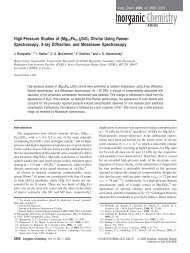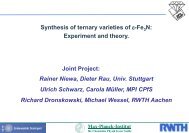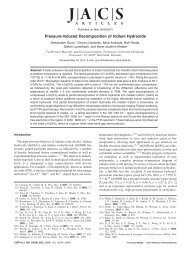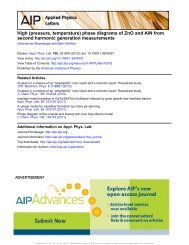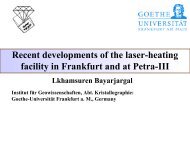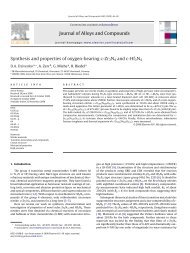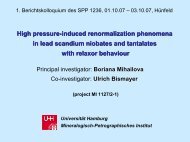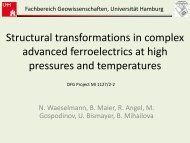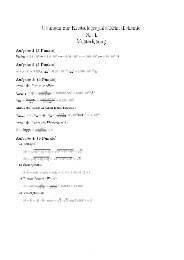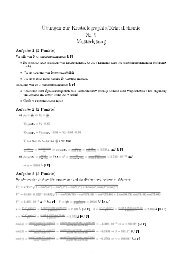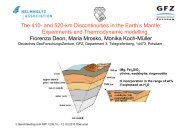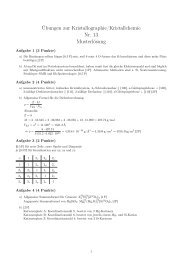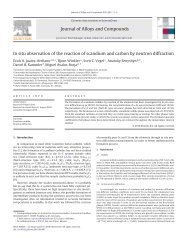Raman spectroscopic study of PbCO3 at high pressures and ...
Raman spectroscopic study of PbCO3 at high pressures and ...
Raman spectroscopic study of PbCO3 at high pressures and ...
You also want an ePaper? Increase the reach of your titles
YUMPU automatically turns print PDFs into web optimized ePapers that Google loves.
Fig. 11 Pressure dependence <strong>of</strong><br />
internal <strong>Raman</strong> frequencies <strong>of</strong><br />
<strong>PbCO3</strong> <strong>at</strong> 544(3) K upon<br />
decompression: a v 4-in-plane<br />
b<strong>and</strong> [1 B 3g (open left triangle),<br />
2 A 1g (filled circle), 3 B 2g (small<br />
rhombus), I, II, III the fields <strong>of</strong><br />
existence <strong>of</strong> phases I, II, III,<br />
respectively; b v 2-out-<strong>of</strong>-plane<br />
b<strong>and</strong> (filled circle); c v 1 (filled<br />
triangle), v 1 0 (open circle)<br />
symmetric stretching vibr<strong>at</strong>ions;<br />
d v 2 0 -out-<strong>of</strong>-plane b<strong>and</strong> (filled<br />
triangle). The size <strong>of</strong> the<br />
symbols corresponds to errors<br />
in wavenumber <strong>and</strong> P<br />
<strong>high</strong>-pressure polymorph could be more compressible than<br />
cerussite as discussed before. The structure <strong>of</strong> this new<br />
phase has not been determined yet.<br />
The form<strong>at</strong>ion <strong>of</strong> <strong>PbCO3</strong>-III has been previously<br />
observed by Lin <strong>and</strong> Liu (1997a, 1997b), <strong>and</strong> also by<br />
C<strong>at</strong>alli et al. (2005). It sets in <strong>at</strong> about 10 GPa <strong>and</strong> is<br />
completed <strong>at</strong> about 16 GPa. Different pressure transmitting<br />
media used by Lin <strong>and</strong> Liu (1997a) (w<strong>at</strong>er) <strong>and</strong> C<strong>at</strong>alli<br />
et al. (2005) could account for the reported differences<br />
between both studies. At room temper<strong>at</strong>ure a mixture <strong>of</strong><br />
phases II <strong>and</strong> III exists in the pressure range from 10 to<br />
16 GPa . There is only one d<strong>at</strong>a point available above<br />
700 K <strong>and</strong> 7.6 GPa, we cannot exclude th<strong>at</strong> this is an<br />
outlier <strong>and</strong> it should be regarded with due caution. The<br />
approxim<strong>at</strong>e position <strong>of</strong> the anticip<strong>at</strong>ed triple point in the<br />
phase diagram was determined as follows: (1) the I–II<br />
phase boundary was linearly extrapol<strong>at</strong>ed; (2) the end <strong>of</strong><br />
the II–III phase boundary (<strong>at</strong> 12.2(2) GPa/544 K) was<br />
123<br />
v 1 '<br />
v 4<br />
v 1<br />
(a) (b)<br />
(c)<br />
(d)<br />
Phys Chem Minerals<br />
connected with the last measured point <strong>at</strong> 7.6(2) GPa/<br />
718 K <strong>and</strong> extrapol<strong>at</strong>ed to determine the crossing point<br />
with the I–II phase boundary. The crossing point was then<br />
connected with the point <strong>at</strong> 4 GPa <strong>and</strong> 1,273 K, which<br />
corresponds to phase III <strong>of</strong> Lin <strong>and</strong> Liu (1997a). The <strong>high</strong>pressure<br />
phase <strong>PbCO3</strong>-II in Lin <strong>and</strong> Liu (1997a) (phase III<br />
in this paper) was obtained by quenching from 1,273 K<br />
<strong>and</strong> 4 GPa. This means th<strong>at</strong> PbCO 3-II in Lin <strong>and</strong> Liu<br />
(1997a) may not be identical with the <strong>high</strong>-pressure phase<br />
observed in situ (22 GPa/298 K) in Lin <strong>and</strong> Liu (1997b),<br />
provided the phase <strong>at</strong> 4 GPa <strong>and</strong> 1,273 K is not quenchable.<br />
Th<strong>at</strong> was the reason to draw a part <strong>of</strong> the II-III phase<br />
boundary as dashed line. It should be noted th<strong>at</strong> <strong>PbCO3</strong>-I<br />
possibly does not crystallize in the ‘true’ aragonite-type<br />
structure (Durman et al. 1985), possibly due to the presence<br />
<strong>of</strong> the 6s 2 -lone pair <strong>of</strong> Pb 2? . Hence, the occurrence <strong>of</strong><br />
PbCO 3-II could be anomalous with respect to the closedshall<br />
aragonite type carbon<strong>at</strong>es. The question whether a



